Analysis of Current and Future Forest Disturbances Dynamics in Central Europe
Abstract
1. Introduction
2. Materials and Methods
- μt—The mean value of the trend component that changes at time t;
- βt—The slope of the trend that changes at time t;
- sp(t)—Seasonal component for one of the “p” periods;
- εt—Residual component;
- t—Time variable.
- Lt—Estimate of the mean value of the time series μt;
- Tt—Estimate of the trend component βt;
- St–Estimate of the seasonal component;
- α, γ, δ—Balancing the model weights with values from the interval between 0 and 1;
- p—Number of periods per year.
3. Results
3.1. Development of Timber Harvesting in Selected European Countries
3.2. Statistical Prediction of the Development of Incidental Felling Volumes
3.3. Prediction of the Development of Incidental Fellings Using the SIBYLA Growth Simulator
4. Discussion
5. Conclusions
Author Contributions
Funding
Data Availability Statement
Conflicts of Interest
References
- Hanberry, B.B. Forest Disturbance Types and Current Analogs for Historical Disturbance-Independent Forests. Land 2021, 10, 136. [Google Scholar] [CrossRef]
- Merganič, J.; Allman, M.; Dudáková, Z.; Bahýl, J.; Ferenčík, M.; Jakubis, M.; Jankovský, M.; Juško, V.; Kardoš, M.; Meloun, D.; et al. Disturbancie v Lesných Ekosystémoch a Možnosti Ich Kvantifikácie a Predikcie Pre Potreby Lesného Hospodárstva [Disturbances in Forest Ecosystems and Possibilities for Its Quantification and Prediction for Forest Management Needs], 1st ed.; Technical University in Zvolen: Zvolen, Slovakia, 2020; p. 441. [Google Scholar]
- Seidl, R.; Thom, D.; Kautz, M.; Martin-Benito, D.; Peltoniemi, M.; Vacchiano, G.; Wild, J.; Ascoli, D.; Petr, M.; Honkaniemi, J.; et al. Forest disturbances under climate change. Nat. Clim. Chang. 2017, 7, 395–402. [Google Scholar] [CrossRef] [PubMed]
- Schelhaas, M.J. Impacts of Natural Disturbances on the Development of European Forest Resources: Application of Model Approaches from Tree and Stand Levels to Large-Scale Scenarios, 1st ed.; Alterra Scientific Contributions 23; Alterra: Wageningen, The Netherland, 2008; p. 22. [Google Scholar]
- Lampainen, J.; Kuuluvainen, T.; Wallenius, T.H.; Karjalainen, L.; Vanha-Majamaa, I. Long-term forest structure and regeneration after wildfire in Russian Karelia. J. Veg. Sci. 2004, 15, 245–256. [Google Scholar] [CrossRef]
- Dale, V.H.; Joyce, L.A.; McNulty, S.; Neilson, R.P.; Ayres, M.P.; Flannigan, M.D.; Hanson, P.J.; Irland, L.C.; Lugo, A.E.; Peterson, C.J.; et al. Climate change and forest disturbances. Bioscience 2001, 51, 723–734. [Google Scholar] [CrossRef]
- Frelich, L.E. Forest Dynamics and Disturbance Regimes: Studies from Temperate Evergreen-Deciduous Forests, 1st ed.; Cambridge University Press: Cambridge, UK, 2002; p. 265. [Google Scholar] [CrossRef]
- Volney, W.J.A.; Hirsch, K.G. Disturbing forest disturbances. For. Chron. 2005, 81, 662–668. [Google Scholar] [CrossRef]
- Seidl, R.; Fernandes, P.M.; Fonseca, T.F.; Gillet, F.; Jonsson, A.M.; Merganičová, K.; Netherer, S.; Arpaci, A.; Bontemps, J.D.; Bugmann, H.; et al. Modelling natural disturbances in forest ecosystems: A review. Ecol. Model. 2011, 222, 903–924. [Google Scholar] [CrossRef]
- Kangur, A.; Yoshida, T.; Kubota, Y.; Metslaid, M. Approaches for forest disturbance studies: Natural variability and tree regeneration. J. For. Res. 2011, 16, 153–154. [Google Scholar] [CrossRef][Green Version]
- Espirito-Santo, F.D.B.; Gloor, M.; Keller, M.; Malhi, Y.; Saatchi, S.; Nelson, B.; Oliveira, R.C.; Pereira, C.; Lloyd, J.; Frolking, S.; et al. Size and frequency of natural forest disturbances and the Amazon forest carbon balance. Nat. Commun. 2014, 5, 3434. [Google Scholar] [CrossRef]
- Thom, D.; Seidl, R. Natural disturbance impacts on ecosystem services and biodiversity in temperate and boreal forests. Biol. Rev. 2016, 91, 760–781. [Google Scholar] [CrossRef]
- Jogiste, K.; Korjus, H.; Stanturf, J.A.; Frelich, L.E.; Baders, E.; Donis, J.; Jansons, A.; Knagur, A.; Koster, K.; Laarmann, D.; et al. Hemiboreal forest: Natural disturbances and the importance of ecosystem legacies to management. Ecosphere 2017, 8, e01706. [Google Scholar] [CrossRef]
- Schelhaas, M.J.; Nabuurs, G.J.; Schuck, A. Natural disturbances in the European forests in the 19th and 20th centuries. Glob. Chang. Biol. 2003, 9, 1620–1633. [Google Scholar] [CrossRef]
- Cada, V.; Morrissey, R.C.; Michalova, Z.; Bace, R.; Janda, P.; Svoboda, M. Fequent severe natural disturbances and non-equilibrium landscape dynamics shaped the mountain spruce forest in central Europe. For. Ecol. Manag. 2016, 363, 169–178. [Google Scholar] [CrossRef]
- Coates, T.A.; Johnson, A.; Aust, W.M.; Hagan, D.L.; Chow, A.T.; Trettin, C. Forest composition, fuel loading, and soil chemistry resulting from 50 years of forest management and natural disturbance in two southeastern Coastal Plain watersheds, USA. For. Ecol. Manag. 2020, 473, 118337. [Google Scholar] [CrossRef]
- Lecina-Diaz, J.; Martinez-Vilalta, J.; Alvarez, A.; Banque, M.; Birkmann, J.; Feldmeyer, D.; Vayreda, J.; Retana, J. Characterizing forest vulnerability and risk to climate-change hazards. Front. Ecol. Environ. 2020, 19, 126–133. [Google Scholar] [CrossRef]
- Overpeck, J.T.; Rind, D.; Goldberg, R. Climate-induced in Forest Disturbance and Vegetation. Nature 1990, 343, 51–53. [Google Scholar] [CrossRef]
- Kron, W. Flood risk = Hazard center dot values center dot vulnerability. Water Int. 2005, 30, 58–68. [Google Scholar] [CrossRef]
- Lorimer, C.G.; White, A.S. Scale and frequency of natural disturbances in the northeastern US: Implications for early successional forest habitats and regional age distributions. For. Ecol. Manag. 2003, 185, 41–64. [Google Scholar] [CrossRef]
- Caplat, P.; Anand, M. Effects of disturbance frequency, species traits and resprouting on directional succession in an individual-based model of forest dynamics. J. Ecol. 2009, 97, 1028–1036. [Google Scholar] [CrossRef]
- Thom, D.; Seidl, R.; Steyrer, G.; Krehan, H.; Formayer, H. Slow and fast drivers of the natural disturbance regime in Central European forest ecosystems. For. Ecol. Manag. 2013, 307, 293–302. [Google Scholar] [CrossRef]
- Svoboda, M.; Janda, P.; Nagel, T.A.; Fraver, S.; Rejzek, J.; Bace, R. Disturbance history of an old-growth sub-alpine Picea abies stand in the Bohemian Forest, Czech Republic. J. Veg. Sci. 2012, 23, 86–97. [Google Scholar] [CrossRef]
- Cada, V.; Trotsiuk, V.; Janda, P.; Mikolas, M.; Bace, R.; Nagel, T.A.; Morrissey, R.C.; Tepley, A.J.; Vostarek, O.; Begovic, K.; et al. Quantifying natural disturbances using a large-scale dendrochronological reconstruction to guide forest management. Ecol. Appl. 2020, 30, 02189. [Google Scholar] [CrossRef]
- Munteanu, C.; Nita, M.D.; Abrdan, L.V.; Radeloff, V.C. Historical forest management in Romania is imposing strong legacies on contemporary forests and their management. For. Ecol. Manag. 2016, 361, 179–193. [Google Scholar] [CrossRef]
- Allen, C.D.; Macalady, A.K.; Chenchoni, H.; Bachelet, D.; McDowell, N.; Vennetier, M.; Kitzberger, T.; Rigling, A.; Breshears, D.D.; Hogg, E.H.; et al. A global overview of drought and heat-induced tree mortality reveals emerging climate change risks for forests. For. Ecol. Manag. 2010, 259, 660–684. [Google Scholar] [CrossRef]
- Knutti, R.; Sedlacek, J. Robustness and uncertainties in the new CMIP5 climate model projections. Nat. Clim. Chang. 2013, 3, 369–373. [Google Scholar] [CrossRef]
- Reyer, C.; Lasch-Born, P.; Suckow, F.; Gutsch, M.; Murawski, A.; Pilz, T. Projections of regional changes in forest net primary productivity for different tree species in Europe driven by climate change and carbon dioxide. Ann. For. Sci. 2014, 71, 211–225. [Google Scholar] [CrossRef]
- Mitchell, S.J. A diagnostic framework for windthrow risk estimation. For. Chron. 1998, 74, 100–105. [Google Scholar] [CrossRef]
- Holécy, J.; Hannewinkel, M. A forest management risk insurance model and its application to coniferous stands in southwest Germany. For. Policy Econ. 2006, 8, 161–174. [Google Scholar] [CrossRef]
- Brunette, M.; Holécy, J.; Sedliak, M.; Tuček, J.; Hanewinkel, M. An actuarial model of forest insurance against multiple natural hazards in fir (Abies Alba Mill.) stands in Slovakia. For. Policy Econ. 2015, 55, 46–57. [Google Scholar] [CrossRef]
- Korena Hillayova, M.; Balikova, K.; Giertliová, B.; Drábek, J.; Holécy, J. Possibilities of forest property insurance against the risk of fire in Slovakia. J. For. Sci. 2021, 67, 204–211. [Google Scholar] [CrossRef]
- Mitchell, S.J.; Ruel, J.C. Modeling windthrow at stand and landscape scales. In Simulation Modeling of Forest Landscape Disturbances, 1st ed.; Perera, A.H., Sturtevant, B.R., Buse, L.J., Eds.; Springer International Publishing: Cham, Switzerland, 2015; pp. 17–43. [Google Scholar] [CrossRef]
- Ministry of Agriculture and Rural Development of the Slovak Republic. Green Reports 1990–2020. Available online: https://www.mpsr.sk/?navID=123 (accessed on 27 December 2021).
- Czech Statistical Office. Forestry Statistics 1990–2020. Available online: https://www.czso.cz/csu/czso/forestry (accessed on 27 December 2021).
- Statistisches Bundesamt Deutschland. Forestry and Wood Statistics 1990–2020. Available online: https://www.destatis.de/EN/Themes/Economic-Sectors-Enterprises/Agriculture-Forestry-Fisheries/Forestry-Wood/_node.html (accessed on 27 December 2021).
- Federal Ministry Republic of Austria Agriculture, Regions and Tourism. Daten Holzeinschlag 1990–2020 [Timber Harvesting Data 1990–2020]. Available online: https://info.bmlrt.gv.at/themen/wald/wald-in-oesterreich/wald-und-zahlen/Holzeinschlag/holzeinschlagsmeldung-2020.html (accessed on 27 December 2021).
- Federal Office for the Environment Switzerland. Jahrbuch Wald und Holz 1990–2020 [Yearbook Forests and Wood 1990–2020]. Available online: https://www.bafu.admin.ch/bafu/de/home/themen/wald/publikationen-studien/publikationen/jahrbuch-wald-und-holz.html (accessed on 27 December 2021).
- Stoheker, S.; Vőgtli, I.; Bader, M.; Queloz, V. Befall Durch Den Buchdrucker (Ips Typohraphus) Weiterhin Hoch. [Insect Infestation (Ips Typohraphus) Remains High]. In Waldschutz Aktuell; Swiss Federal Research Institute: Birmensdorf, Switzerland, 2021; Volume 1, p. 3. Available online: https://www.wsl.ch/de/publikationen/default-392f0e692d.html (accessed on 27 December 2021).
- State Forests of Poland. Forest Report in Poland 1990–2020. Available online: https://www.lasy.gov.pl/pl/informacje/publikacje/informacje-statystyczne-i-raporty/raport-o-stanie-lasow (accessed on 27 December 2021).
- Fabrika, M.; Valent, P.; Macková, L.; Mokroš, M. Sibyla Triquetra. Freeware Software. 2016. Available online: http://sibyla.tuzvo.sk/software.html (accessed on 27 December 2021).
- Fabrika, M.; Vaculčiak, T. Modeling natural disturbances in tree growth model SIBYLA. In Proceedings of the Bioclimatology and Natural Hazards, Polana, Slovakia, 17 December 2007. [Google Scholar] [CrossRef]
- Spulak, O.; Soucek, J. The Sibyla model and development of beech forests affected by air pollution. Cent. Eur. J. Biol. 2010, 5, 371–383. [Google Scholar] [CrossRef]
- Bošeľa, M.; Petráš, R.; Šebeň, V.; Mecko, J.; Marušák, R. Evaluating competitive interactions between trees in mixed forests in the Western Carpathians: Comparison between long-term experiments and SIBYLA simulations. For. Ecol. Manag. 2013, 310, 577–588. [Google Scholar] [CrossRef]
- Trombik, J.; Barka, I.; Hlásny, T. Effect of different tree mortality patterns on stand development in the forest model SIBYLA. Cent. Eur. For. J. 2016, 62, 173–180. [Google Scholar] [CrossRef][Green Version]
- Winters, P.R. Forecasting sales by exponentially weighted moving averages. Manag. Sci. 1960, 6, 324–342. [Google Scholar] [CrossRef]
- Kendall, M.G. Time Series Analysis, Forecasting and Control—Box, G.E.P. and Jenkins, G.M. J. R. Stat. Soc. Ser. A 1971, 134, 450–453. [Google Scholar] [CrossRef]
- Aszalos, R.; Somodi, I.; Kenderes, K.; Ruff, J.; Czucz, B.; Standovar, T. Accurate prediction of ice disturbance in European deciduous forests with generalized linear models: A comparison of field-based and airborne-based approaches. Eur. J. For. Res. 2012, 131, 1905–1915. [Google Scholar] [CrossRef]
- Stankovičová, I. Modeling of employment trends in the Slovak Republic and the Czech Republic. In Proceedings of the Re-Production of Human Capital—Mutual Links and Connections, Prague, Czech Republic, 7–8 November 2019. [Google Scholar]
- Forzieri, G.; Pecchi, M.; Girardello, M.; Mauri, A.; Klaus, M.; Nikolov, C.; Ruetschi, M.; Gardiner, B.; Tomastik, J.; Small, D.; et al. A spatially explicit database of wind disturbances in European forests over the period 2000–2018. Earth Syst. Sci. Data 2020, 12, 257–276. [Google Scholar] [CrossRef]
- Seidl, R.; Schelhaas, M.J.; Rammer, W.; Verkerk, P.J. Increasing forest disturbances in Europe and their impact on carbon storage. Nat. Clim. Chang. 2014, 4, 806–810. [Google Scholar] [CrossRef]
- Seidl, R.; Schelhaas, M.J.; Lindner, M.; Lexer, M.J. Modelling bark beetle disturbances in a large scale forest scenario model to assess climate change impacts and evaluate adaptive management strategies. Reg. Environ. Chang. 2009, 9, 101–119. [Google Scholar] [CrossRef]
- Melo, L.C.; Schneider, R.; Fortin, M. The effect of natural and anthropogenic disturbances on the uncertainty of large-area forest growth forecasts. Forestry 2019, 92, 231–241. [Google Scholar] [CrossRef]
- Schelhaas, M.J.; Nabuurs, G.J.; Sonntag, M.; Pussinen, A. Adding natural disturbannces to a large-scale forest scenario model and a case study for Switzerland. For. Ecol. Manag. 2002, 167, 13–26. [Google Scholar] [CrossRef]
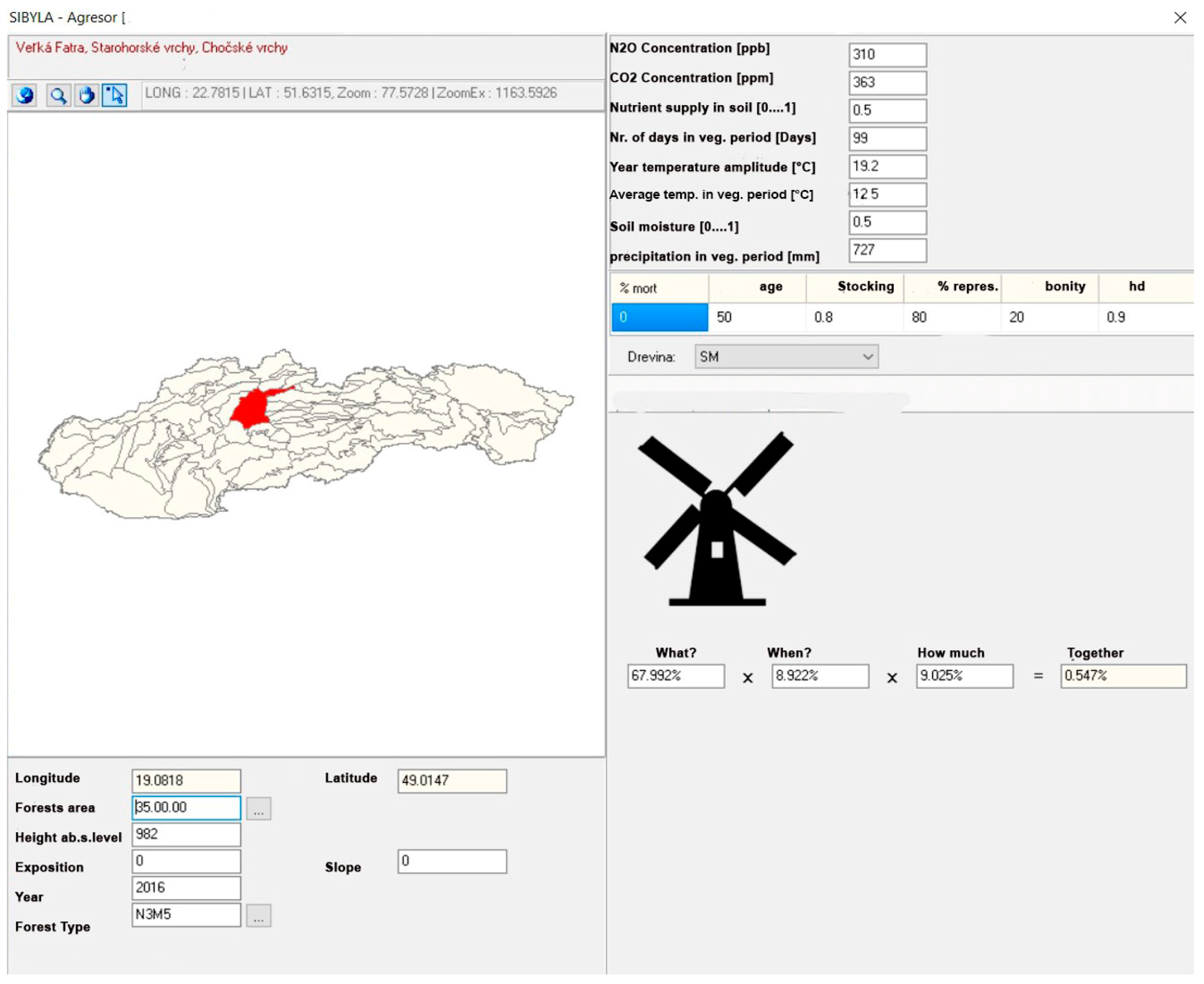
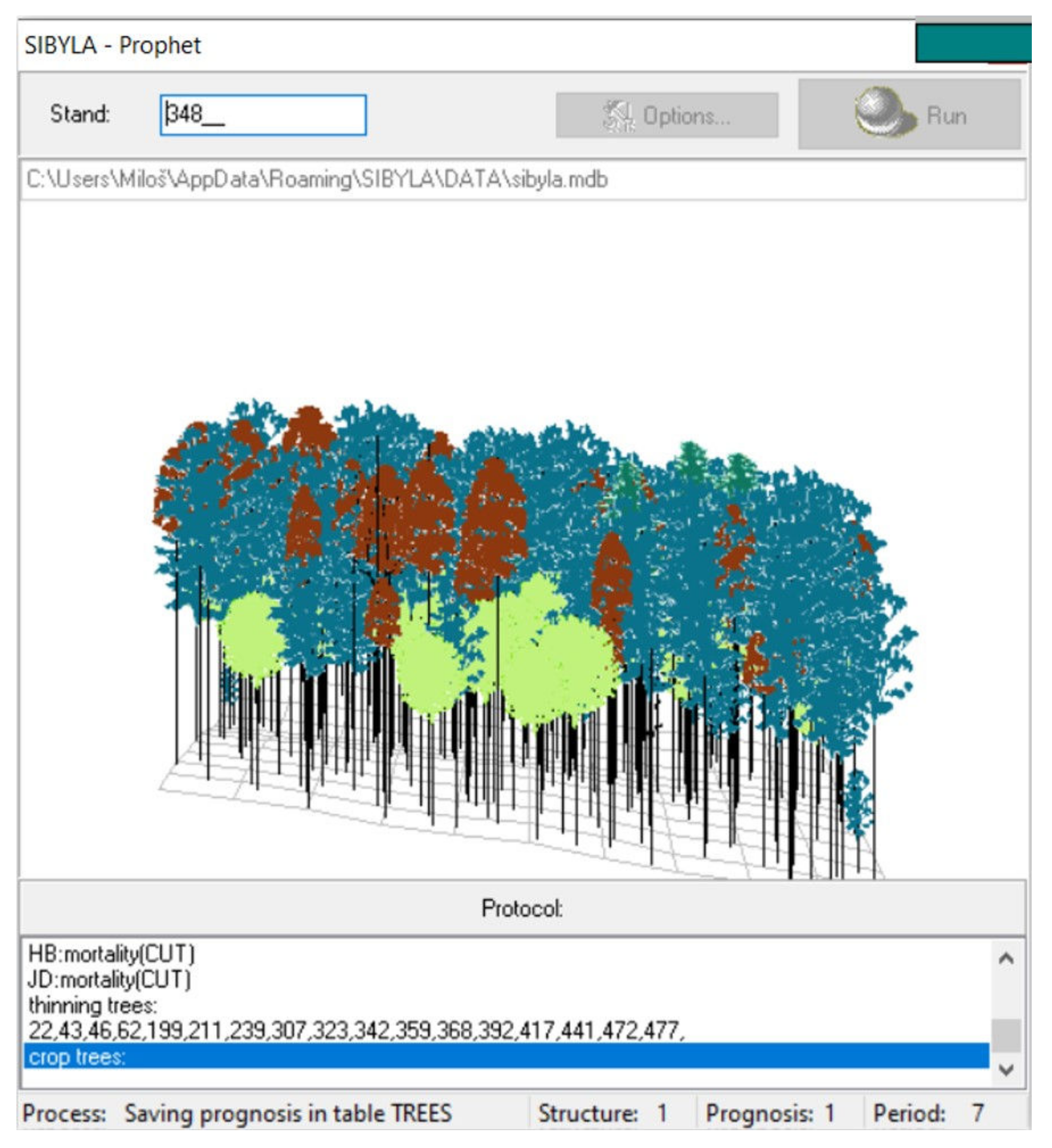
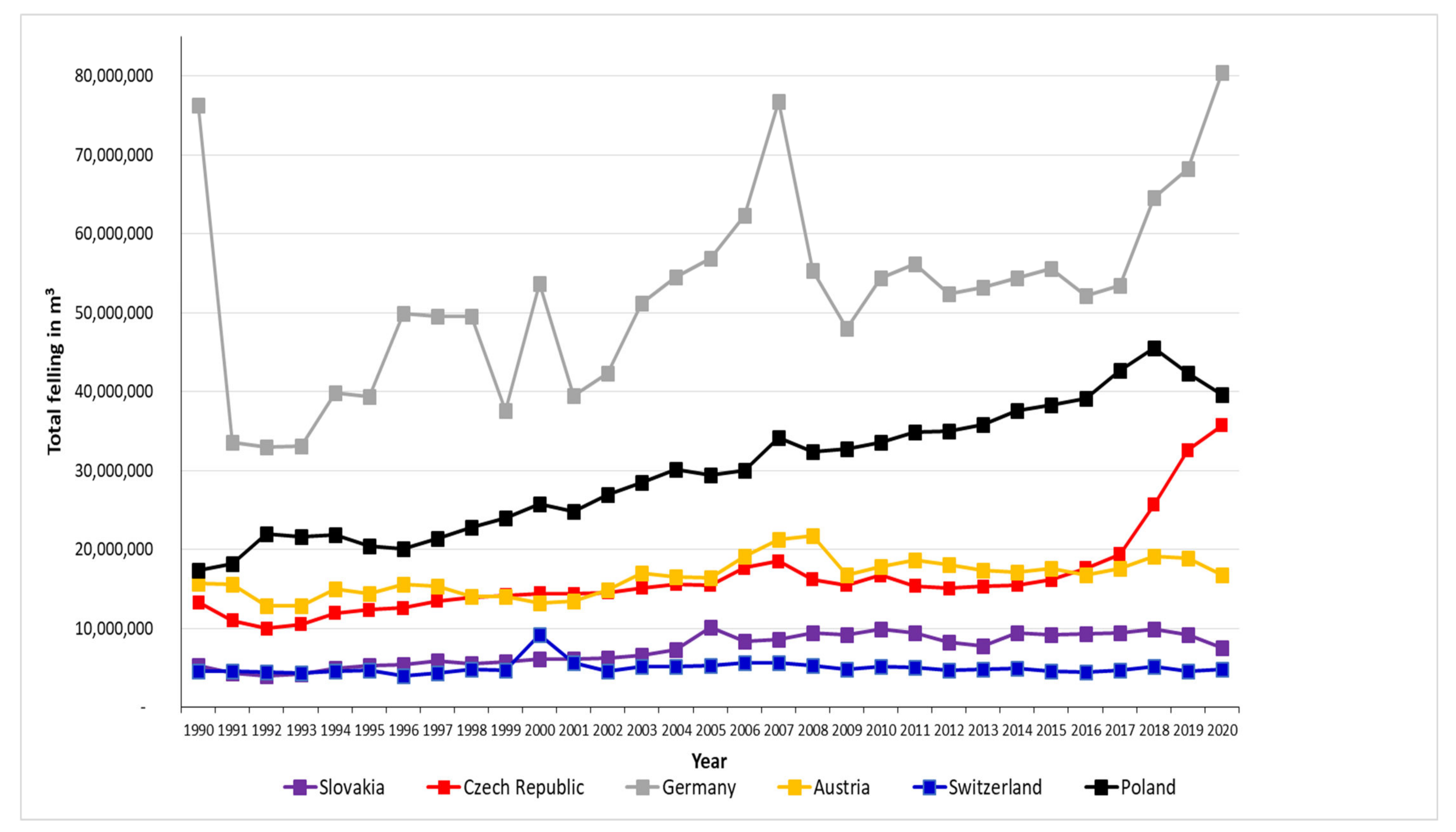
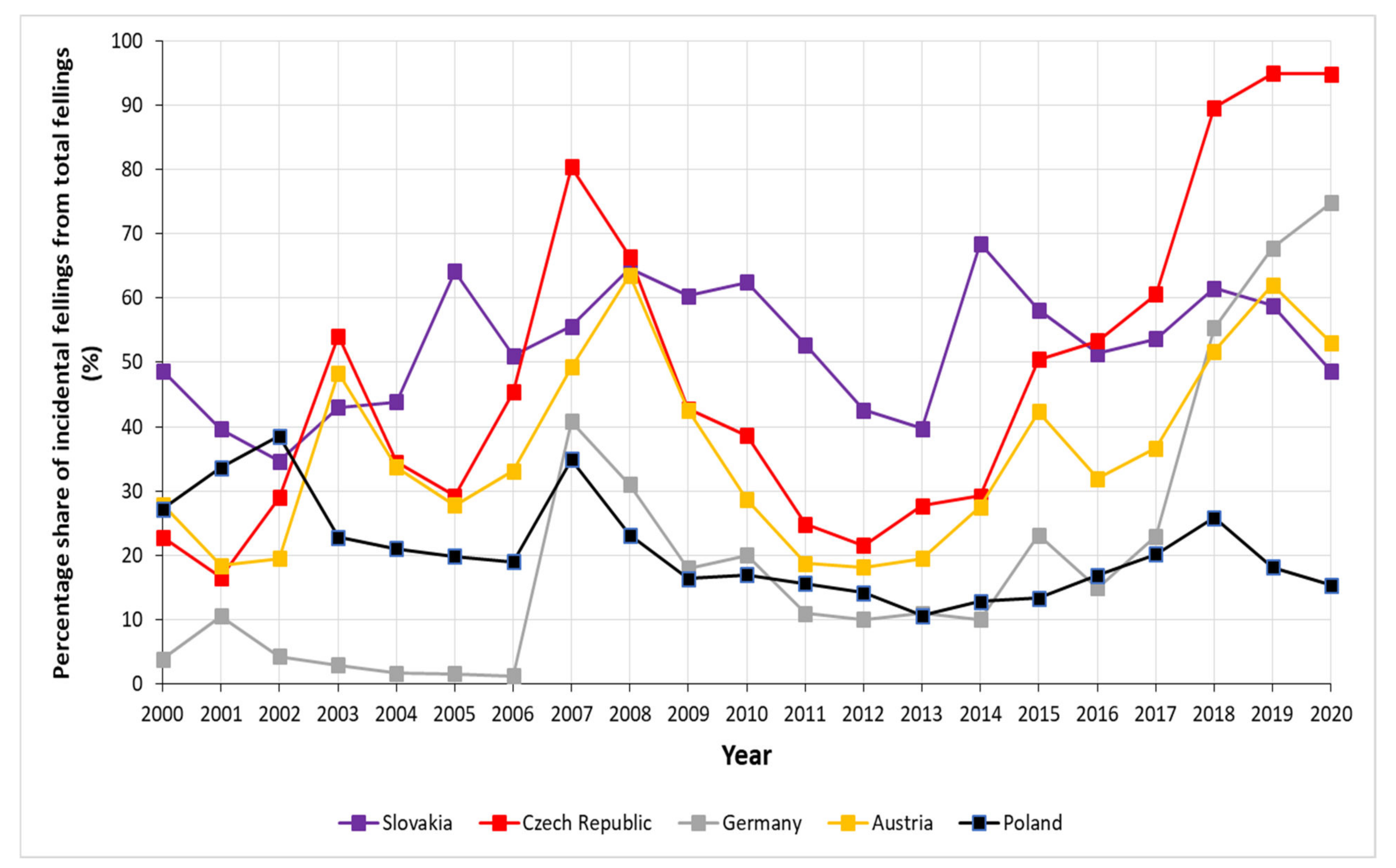
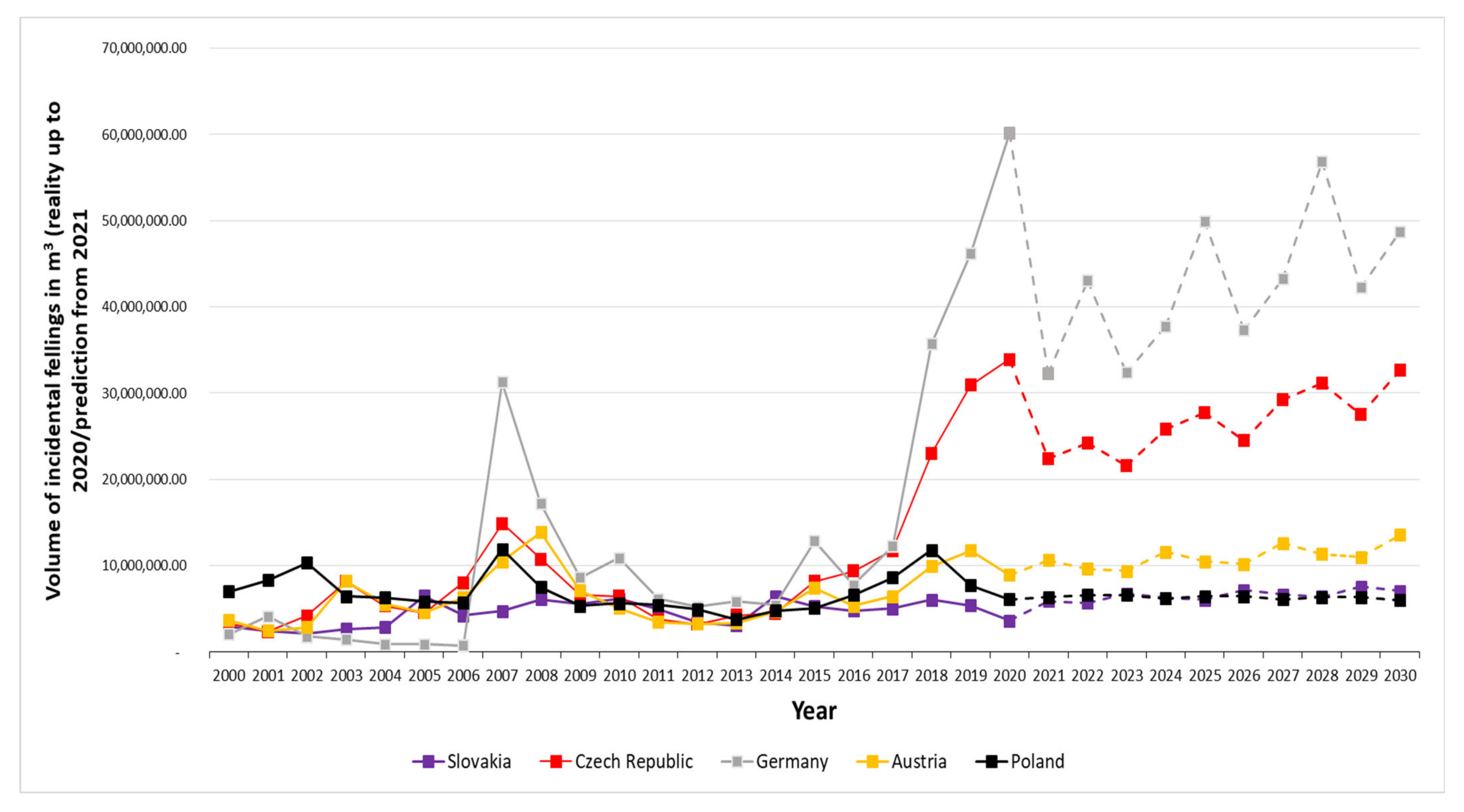

| Country | Information Source | Reference Number |
|---|---|---|
| Slovakia | Forestry Green report from the Ministry of Agriculture and Rural Development of the Slovak Republic | [34] |
| Czech Republic | Czech Statistical Office—Forestry datasheet | [35] |
| Germany | Federal Statistical Office of Germany—Forestry and Wood Statistics | [36] |
| Austria | Federal Ministry Republic of Austria Agriculture, Regions and Tourism—Timber harvesting Data | [37] |
| Switzerland | Federal Office for the Environment Switzerland. Yearbook Forests and Wood (Swiss Federal Research Institute); insect infestation Ips typographus remains high | [38,39] |
| Poland | State Forests of Poland—Forest report in Poland | [40] |
Publisher’s Note: MDPI stays neutral with regard to jurisdictional claims in published maps and institutional affiliations. |
© 2022 by the authors. Licensee MDPI, Basel, Switzerland. This article is an open access article distributed under the terms and conditions of the Creative Commons Attribution (CC BY) license (https://creativecommons.org/licenses/by/4.0/).
Share and Cite
Gejdoš, M.; Michajlová, K. Analysis of Current and Future Forest Disturbances Dynamics in Central Europe. Forests 2022, 13, 554. https://doi.org/10.3390/f13040554
Gejdoš M, Michajlová K. Analysis of Current and Future Forest Disturbances Dynamics in Central Europe. Forests. 2022; 13(4):554. https://doi.org/10.3390/f13040554
Chicago/Turabian StyleGejdoš, Miloš, and Katarína Michajlová. 2022. "Analysis of Current and Future Forest Disturbances Dynamics in Central Europe" Forests 13, no. 4: 554. https://doi.org/10.3390/f13040554
APA StyleGejdoš, M., & Michajlová, K. (2022). Analysis of Current and Future Forest Disturbances Dynamics in Central Europe. Forests, 13(4), 554. https://doi.org/10.3390/f13040554







